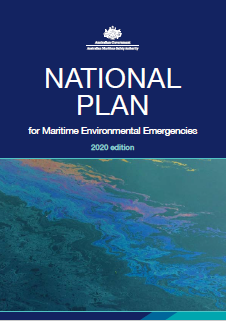The National Plan, implemented in 1973, provides a single national, comprehensive and integrated response for minimising the impacts of marine pollution from spills and other maritime emergencies on:
- the Australian community
- the environment
- cultural and heritage resources
- the economy
- infrastructure

To maximise Australia's marine pollution response capability, we manage the National Plan by working with:
- Commonwealth, state, and Northern Territory governments
- shipping, ports, oil, salvage, exploration and chemical industries
- emergency services nationwide
To ensure consistency, the National Plan provides policy and guidance on the following:
- governance and strategic management
- casualty prevention
- planning for incident response
- response plans, systems and processes
- recovery and community support
- cost recovery and financial arrangements
It builds on eight important principles common to all forms of emergency response:
- protecting the community, environment and maritime industries
- giving effect to relevant international conventions
- integrating with the Australian emergency management arrangements
- providing a comprehensive management arrangement
- providing a single integrated response arrangement
- implementing a risk management approach
- implementing the polluter pays principles
- providing for stakeholder engagement
Implementation
The National Plan deals with pollution, potential pollution of the sea, or harm to the marine environment by oil or hazardous and noxious substances originating from:
- maritime casualties requiring salvage and intervention, emergency towage and requests for a place of refuge
- oil pollution or hazardous and noxious substance pollution incidents from vessels, oil and chemical terminals, and from offshore petroleum activities
- marine pollution from unknown sources
- marine pollution from floating or sunken containers of hazardous materials
- debris originating from a maritime casualty
- physical damage caused by vessels
It does not deal with ballast water, marine pests, or marine pollutants other than oil and hazardous and noxious substances, general marine debris and rubbish. These areas are managed under other regimes and agreements.
Where does the National Plan apply?
The National Plan applies throughout the Australian exclusive economic zone, and covers all coastal waters, offshore islands and territories.
It also applies on the high seas where an incident has the potential to impact Australian interests.
The National Plan provides:
- detailed national, state, local and industry plans and communications arrangements for responding to oil or chemical pollution incidents
- an appropriate level of emergency towage capability around the Australian coastline
- a single national decision-maker to coordinate responses to maritime casualties
- an adequate level of pre-positioned spill combating equipment, commensurate with the risk involved
- a comprehensive competency-based national training program, complemented by exercises
Related information
- National Plan for maritime environmental emergencies
- National Plan DVD—Responding to marine pollution in Australia
- National Plan governance and management
- National Plan reports
- National Plan commonwealth, state and territory pollution response
- National Plan training